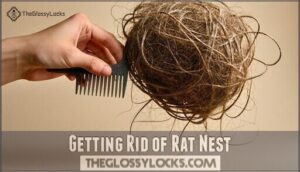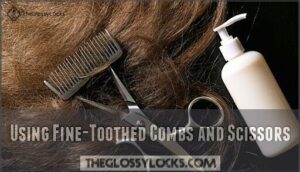This site is supported by our readers. We may earn a commission, at no cost to you, if you purchase through links.
 To get a rat’s nest out of your hair, start by applying a generous amount of conditioner to the tangled area. Let it sit for 5 minutes to soften the knots.
To get a rat’s nest out of your hair, start by applying a generous amount of conditioner to the tangled area. Let it sit for 5 minutes to soften the knots.
Working from the ends up, use a wide-tooth comb or your fingers to gently separate the strands. Hold sections above the tangle to prevent painful pulling on your scalp.
For stubborn knots, try adding detangling spray or a few drops of oil. Once the major tangles are gone, wash your hair normally.
Patience is key—rushing through this process might cost you more than just time, as properly preserving your locks requires the right technique.
Table Of Contents
- Key Takeaways
- Removing Rat Nest
- Getting Rid of Rat Nest
- Detangling Techniques
- Preventing Future Rat Nests
- Specialized Rat Nest Removal
- Post-Detangling Hair Care
- Frequently Asked Questions (FAQs)
- How do you get rid of a rat nest?
- How to get rid of rats from your home?
- How to avoid a rat’s nest on your head?
- Is there a rat nest in your hair?
- How do you get rats nest out of hair?
- How do you get the worst knots out of your hair?
- How do you remove a rats nest?
- Why do I keep getting rats in my hair?
- How long does detangling a rats nest take?
- Will cutting the rats nest affect hair growth?
- Conclusion
Key Takeaways
- Apply a generous amount of conditioner or detangling spray to wet hair, letting it sit for a few minutes to soften knots.
- Work on small sections, starting at the ends, using your fingers or a wide-tooth comb to gently remove tangles.
- For stubborn knots, add oil or detangling spray and avoid pulling to prevent breakage.
- Protect your hair from future tangles by moisturizing regularly, using silk pillowcases, and brushing daily.
Removing Rat Nest
Getting a rat’s nest out of your hair may seem tricky, but with the right steps, it’s totally manageable.
Start by preparing your hair with moisture and working gently to reduce damage while tackling those stubborn knots.
Preparing Hair for Detangling
Start by evaluating hair damage and focusing on scalp health.
Wet your matted hair thoroughly for a pre-detangle soak.
Choose a detangling spray or a deep conditioner suited for your hair type.
Apply generously to the rats nest and let it sit for a few minutes.
Use sectioning strategies to work in small areas, minimizing hair breakage.
Using Detangling Tools and Techniques
Once your hair’s prepped, it’s time for the right tools and detangling techniques.
Use a detangling brush, wide-tooth comb, or your fingers for gradual detangling. Rely on wet detangling and keep applying product if needed.
Divide matted hair into small sections to manage the rats nest methodically. Many find success using a specialized hair tool.
- Tool Selection: Gentle tools prevent breakage.
- Sectioning Methods: Work bit by bit.
- Product Application: Keeps hair slippery.
- Patience: Slow beats pulling!
Preventing Breakage and Damage
When working through matted hair, patience is your best friend.
Use protective styles like braids to avoid severe tangles later. Gentle accessories like silk scarves or fabric ties prevent breakage.
Keep your hair hydrated to strengthen strands and minimize damaged hair. Skip heat styling—it worsens hair breakage.
Focus on proper hair detangling, starting at the ends, for smooth results.
Getting Rid of Rat Nest
Tackling severe matting or a rats nest in your hair might feel intimidating, but it’s doable with patience and the right approach.
Begin by addressing product buildup—focus on using a clarifying shampoo if necessary, as residue can make severe tangles tougher to manage. For matted hair, saturate strands thoroughly with water and apply a rich conditioner or detangling spray to soften knots.
DIY remedies like apple cider vinegar mixed with water can help loosen stubborn tangles. Consider using a pre-shampoo treatment to protect hair before washing.
Work in small sections, starting at the ends, and gently pull apart knots with your fingers or a wide-tooth comb. If needed, consider professional intervention for expert rat nest removal, especially if scalp health is compromised.
Avoid rushing—it’s a process, but smooth, tangle-free hair is worth it!
Detangling Techniques
Tackling a rat’s nest in your hair might seem overwhelming, but the right detangling techniques can make it manageable.
With a little patience and the right approach, you’ll have your hair smooth and knot-free in no time.
Wetting and Conditioning Hair
Getting ready to tackle matted hair or hair knots? Wet it thoroughly with lukewarm water for ideal saturation levels.
Apply a moisturizing conditioner or detangling spray generously, focusing on tangled hair. Let product absorption happen for five to thirty minutes—patience pays off!
Softer strands make detangling a breeze. For enhanced detangling, consider using products with slippery elm ingredients.
Choose conditioner types that fit your needs for extra smoothness and use them to make detangling easier with detangling spray and moisturizing conditioner.
Sectioning and Working Through Knots
Now that your hair is wet and conditioned, divide it into small sections for easier knot removal.
Isolate one matted area at a time using clips to secure the rest. Start from the bottom of each knot, using gradual detangling techniques to work through tangles.
Your finger dexterity is valuable here – pinch the base of knots to prevent pulling at your scalp. Tackle each section methodically until your rats nest becomes manageable, using techniques that require patience and gentle knot removal.
Using Fingers and Wide-Tooth Combs
When dealing with a rat’s nest, your fingers are your best first tool.
Start with finger detangling to gently separate larger knots before introducing a wide-tooth comb.
Work from the ends upward using a gradual detangling approach.
For matted hair, use the sectioning method—divide and conquer.
Your wide-tooth comb should follow your fingers, never force through knots, to prevent breakage during knot removal.
Preventing Future Rat Nests
You’ve conquered that rat’s nest in your hair, but now it’s time to keep those tangles from coming back.
You’ll need to establish a regular hair care routine that includes daily brushing, protective hairstyles at night, and plenty of moisturizing products to maintain smooth, knot-free locks, using moisturizing products.
Maintaining Hair Moisture and Hydration
Three key hydration methods will transform your matted hair woes.
Keep your hair moisture levels balanced with weekly hair masks and daily leave-in conditioner. Your product selection matters—choose alcohol-free formulas designed for your hair type.
Implement overnight protection by wearing a silk scarf or bonnet to bed.
Don’t forget scalp health contributes to overall hydration, while environmental factors like sun exposure can quickly dry out your locks.
Using Gentle Hair Accessories and Tools
The right hair accessories can make or break your detangling routine.
Choose fabric elastics instead of rubber bands to prevent snagging. Wrap hair in silk scarves or satin bonnets at night to minimize friction.
For daily maintenance, invest in a quality detangling brush and wide-tooth comb specifically designed for matted hair.
When dealing with a rats nest, wet brushes glide through tangles more easily, reducing breakage.
Avoiding Excessive Heat Styling and Damage
Beyond choosing the right accessories, minimizing heat styling is your next defense against rats nests.
Heat tools can weaken your hair, making it prone to tangling. Always use heat protectants before styling, and consider styling alternatives like air-drying or braids.
When you must use heat, opt for low-heat tools and don’t use them daily.
Remember, well-hydrated hair resists matted tangles, while frequently heat-damaged strands attract them.
Regular Hair Care and Maintenance
Once a month, establish a regular hair care routine to prevent stubborn rat’s nests from forming.
Brush your hair daily with gentle products that won’t strip natural oils. Protect your locks at night with a silk scarf or bonnet.
Don’t skip regular trims to remove split ends.
Environmental factors matter, so consider using UV protection on your hair.
Maintain scalp health through proper hydration – it’s just as important as using a good hair detangler for tangled hair.
Specialized Rat Nest Removal
When you’re dealing with a severe rat’s nest that won’t budge with regular methods, you’ll need specialized removal techniques and tools for effective results.
You can use fine-toothed combs, detangling sprays, or professional help to tackle those stubborn knots that have turned your hair into what feels like an actual home for rodents.
Using Fine-Toothed Combs and Scissors
Now that you’ve taken steps to prevent tangles, let’s tackle that stubborn rats nest with precision tools.
When facing severely matted hair, work from the bottom up using a fine-toothed comb. Apply conditioner first, letting it sit before combing.
It’s important to focus on hair hydration to ease the detangling process.
For stubborn knots, use the pointed end of your comb to dislodge them. As a last resort, practice scissor safety when trimming severely matted sections to minimize damage control.
Applying Detangling Sprays and Conditioners
While fine-toothed combs have their place, detangling sprays and conditioners are your secret weapons against stubborn rat’s nests.
Spray detangler evenly on dry, tangled sections from 5-10 inches away. For oily hair, focus only on larger knots.
Leave-in conditioners offer deeper hydration benefits—apply on damp hair, concentrating on lengths and ends.
Natural ingredients like argan oil, castor oil, and lavender oil tackle hair fall while moisturizing your scalp. Many brands offer a wide variety here.
Work in sections with your fingers before using a wide-tooth comb.
Seeking Professional Help When Needed
If your DIY attempts prove futile against severe matting, it’s time to seek professional help.
A professional hairstylist can safely remove a rats nest without causing extensive breakage.
Consider a stylist consultation when you notice product damage or persistent tangles affecting your scalp health.
Hair salon experts have specialized tools and techniques that overcome DIY limitations, preserving your hair’s integrity while addressing even the most challenging tangles.
Post-Detangling Hair Care
After successfully fighting your hair battle, you’ll need to restore your strands with proper care.
You’ll want to apply a deep conditioning treatment and use quality leave-in products to rebuild strength and shine in your newly detangled hair, focusing on proper care.
Washing and Conditioning Hair
Once you’ve conquered that stubborn rats nest, proper washing and conditioning hair is essential.
Use a gentle shampoo to remove product buildup without stripping moisture. Opt for sulfate-free formulas and moderate water temperature to protect scalp health.
Apply conditioner from mid-shaft to ends, letting it sit for 2-3 minutes. Rinse thoroughly to prevent residue that could lead to future tangles.
Adjust shampoo frequency based on your hair type.
Applying Leave-in Conditioners and Masks
Now that your hair is clean, it’s time to lock in moisture with leave-in conditioners and masks. These products are your hair’s best friends after battling a stubborn rats nest.
- Choose masks with hydration-focused ingredients for maximum damage repair
- Apply leave-in conditioner from mid-shaft to ends where detangling occurred
- Select products specifically designed for your hair type
- Let hair masks sit for 15-30 minutes under a shower cap
- Use a wide-tooth comb to distribute product evenly
Using Hair Oils and Treatments for Strength and Hydration
After nourishing your hair with masks, lock in that goodness with oils and treatments. Apply a lightweight oil to your ends and mid-lengths to prevent future rats nests.
Jojoba or argan oil works wonders for strengthening hair without weighing it down. For intensive repair, consider a specialized hair product.
Choose products with protein treatments for repair and moisture-binding ingredients for hydration. Weekly hair conditioning treatments will rebuild your strands after the trauma of detangling that stubborn knot.
Frequently Asked Questions (FAQs)
How do you get rid of a rat nest?
Just when you’re facing a stubborn rat nest, dampen your hair completely.
Apply detangler, section hair carefully, and work from ends upward with fingers or a wide-tooth comb.
Be patient during the process.
How to get rid of rats from your home?
Seal entry points around your home and set traps in high-activity areas.
Remove food sources by storing items in airtight containers.
You’ll need to clean thoroughly and consider using natural repellents like peppermint oil.
How to avoid a rat’s nest on your head?
Think of prevention like stopping a snowball before it becomes an avalanche.
Brush daily, sleep on silk, and moisturize with leave-in conditioner.
Avoid tight styles and never skip detangling after washing for smooth, stress-free hair, which helps in achieving smooth results.
Is there a rat nest in your hair?
If there’s a rat’s nest in your hair, don’t panic.
Start by soaking your hair with conditioner and water, then gently detangle small sections from the bottom up using your fingers or a wide-tooth comb.
This will help to carefully work out the tangles without causing further knots or breakage.
How do you get rats nest out of hair?
An ounce of prevention is worth a pound of cure.
Wet your hair, apply detangler, and separate it into sections.
Start at the ends with your fingers, then use a wide-tooth comb for stubborn knots.
How do you get the worst knots out of your hair?
Start with wet hair and saturate it with a detangler or conditioner.
Gently separate knots using your fingers, then a wide-tooth comb from the ends up.
Patience and small sections make all the difference, with patience being crucial for effective detangling.
How do you remove a rats nest?
Picture untangling a jungle.
Drench your hair in conditioner, let it soak, then divide it into sections.
Gently work from the ends with fingers or a wide-tooth comb.
Patience is your best detangling tool!
Why do I keep getting rats in my hair?
You might keep getting tangles due to dryness, heat damage, or not brushing regularly.
Sleeping on cotton pillowcases or skipping conditioner can also worsen knots.
Adding moisture and using silk pillowcases can help.
How long does detangling a rats nest take?
Detangling a rat’s nest can take anywhere from 30 minutes to several hours, depending on the severity.
Be patient, work in small sections, and use plenty of detangling products to make the process easier.
Will cutting the rats nest affect hair growth?
Cutting a rat’s nest is like pruning a tree—it doesn’t harm hair growth since growth happens at the roots, not the ends.
However, trim carefully to avoid unnecessary loss and maintain healthy strands.
Conclusion
Struggling with how to get a rats nest out of your hair?
Patience and the right approach can make a big difference.
Start by softening knots with conditioner and gently work through tangles using your fingers or a wide-tooth comb.
Don’t rush—focus on preventing breakage by working section by section.
For stubborn nests, use detangling sprays, oils, or seek professional help if needed.
With proper care, you’ll protect your locks and keep future tangles at bay.
- https://better-notyounger.com/blogs/the-better-blog/rats-nest-hair?srsltid=AfmBOoqZPIrSElBDsCy5gZF04r3kBBkYKlMoy0mQWTED5kRsDrFCo192
- https://boards.weddingbee.com/topic/help-with-untangling-the-rats-nest-that-used-to-be-my-hair/
- https://www.hairdyeforum.com/general-hair-chat-questions/rat-nest-big-knot-in-my-hair-m-help/paged/2/
- https://www.quora.com/When-my-hair-is-a-complete-mess-rat-nest-should-I-brush-it-before-washing-or-afterward













